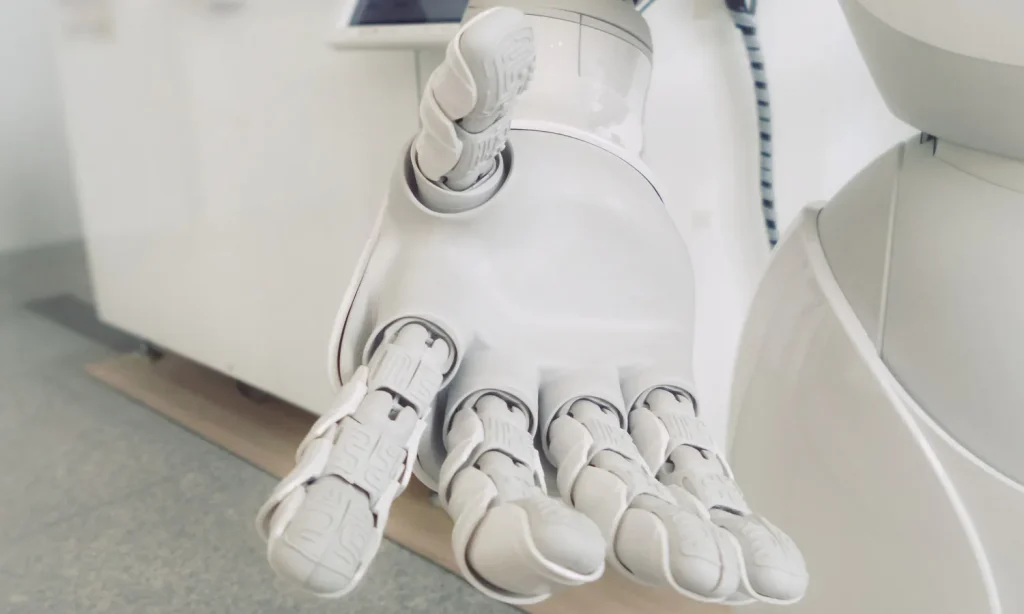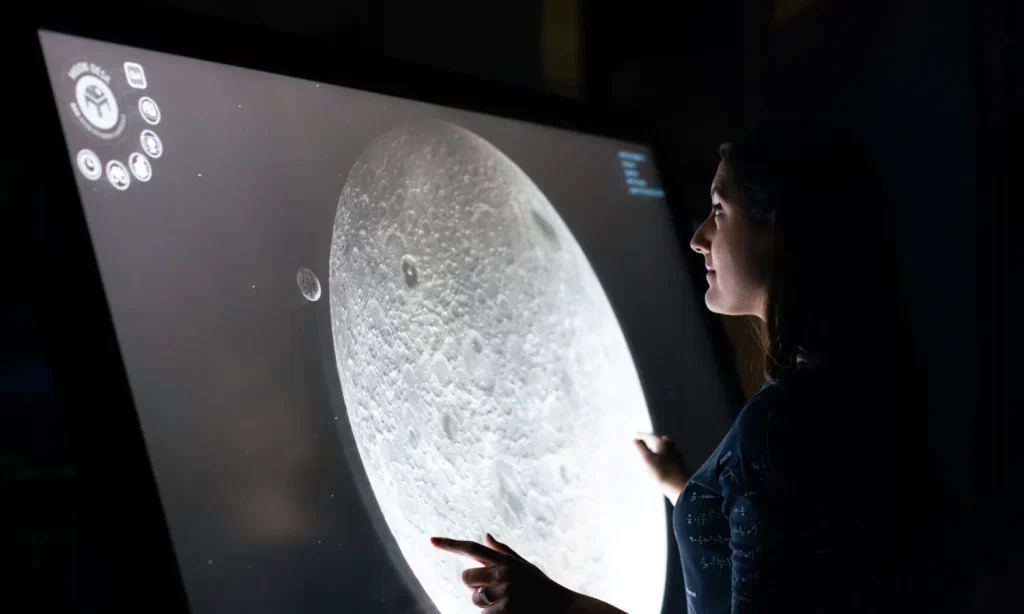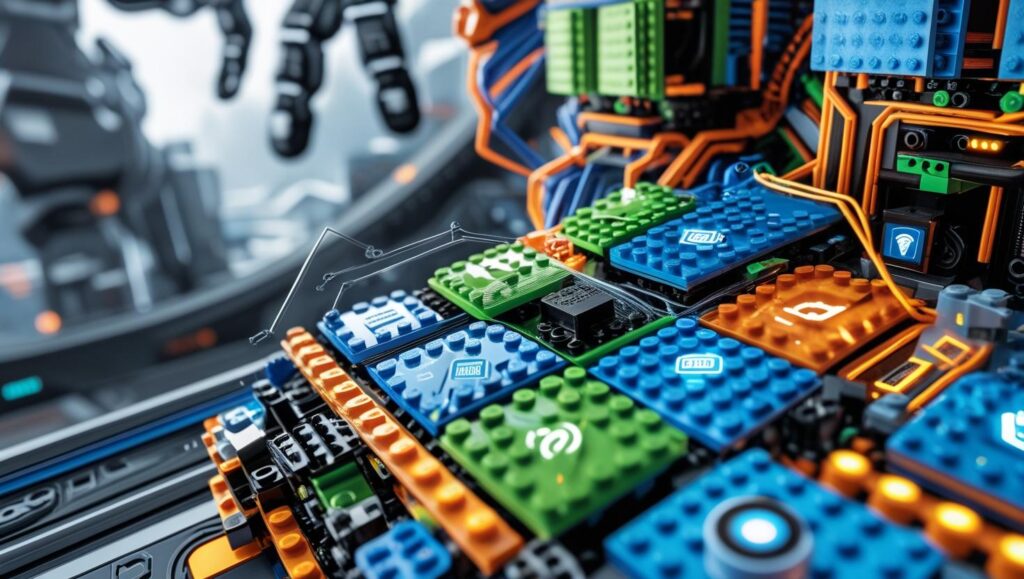Breaking News




Popular News














Enter your email address below and subscribe to our newsletter

What if upgrading your smart home was as simple as snapping LEGO blocks together? While tech giants create mountains of e-waste with every product cycle, a revolutionary architecture is emerging that could transform every electronic device into an evolving, modular ecosystem.

What if upgrading your smart home was as simple as snapping LEGO blocks together? While tech giants create mountains of e-waste with every product cycle, a revolutionary architecture is emerging that could transform every electronic device into an evolving, modular ecosystem. This isn’t just about better gadgets—it’s about democratizing innovation and making electronics development as accessible as building websites.
Picture this: A college student prototypes a professional IoT sensor in 30 minutes during lunch break. A startup scales from brilliant idea to market-ready product in 6 months instead of the typical 18. Your smartphone evolves continuously instead of becoming obsolete every two years. This isn’t science fiction—it’s the inevitable future powered by what I call the Universal Electronics Architecture (UEA).
The companies and innovators building this system today will own tomorrow’s tech landscape. Here’s why this matters to everyone from makers to Fortune 500 CEOs, and how you can be part of the revolution that’s already begun.
Walk into any electronics repair shop and you’ll see the fundamental flaw in our current system. Shelves lined with proprietary parts that work with exactly one device. Drawers full of cables that connect nothing useful anymore. Mountains of “perfectly good” phones that became obsolete not because they broke, but because they couldn’t evolve.
Every electronic device today is an island—isolated, inflexible, and doomed to obsolescence. We’ve built an entire industry around planned obsolescence, where innovation means throwing away the old to make room for the new. The numbers are staggering:
But what if there was a better way? What if electronics could be as modular and adaptive as the software that runs on them?
Imagine walking into an Apple Store in 2030. Instead of choosing between predetermined iPhone models, you build your perfect device from modular components. Need better cameras? Snap in the professional photography module. Want longer battery life? Swap in the extended power pack. Developing an app that requires specialized sensors? Add them seamlessly.

This is the promise of Universal Electronics Architecture—a standardized system that transforms electronics from static products into dynamic, living ecosystems. Think of it as the biological evolution of technology: devices that can adapt, upgrade, and optimize themselves for changing needs without requiring complete replacement.
The concept isn’t entirely new. We’ve seen glimpses of this future in modular phone experiments like Google’s Project Ara and in the maker movement’s embrace of Arduino and Raspberry Pi. But these efforts have been fragmented, limited in scope, or focused on enthusiasts rather than mainstream applications.
UEA changes that by creating a complete, production-ready framework that spans from educational toys to industrial systems, from consumer gadgets to space exploration equipment.
At the foundation lies a standardized connector system that makes USB-C look primitive. This isn’t just about power delivery—it’s about creating a universal language that every electronic component can speak.
The bus delivers multiple voltage rails (3.3V, 5V, 12V) with intelligent power negotiation, ensuring each module gets exactly what it needs without waste. More importantly, it carries multiple communication protocols simultaneously—I2C for sensors, SPI for high-speed data, UART for debugging, and CAN for industrial applications.
Hot-swapping capability means you can literally plug and unplug components while the system is running, just like USB devices on your computer. Built-in protection circuits prevent the magic smoke from escaping when someone inevitably plugs something in wrong.
The brain of the system comes in multiple flavors, from ultra-low-power microcontrollers for sensor nodes to powerful ARM processors for edge computing applications. But here’s the revolutionary part: they all share the same physical and logical interface.
A standardized pinout mapping means a module designed for an ESP32 can work with an ARM Cortex-M4, or even a full Linux system-on-module. The hardware abstraction layer handles the differences, presenting a consistent programming interface regardless of the underlying silicon.
Over-the-air updates are built into the DNA of every processing module, enabling continuous improvement and feature additions throughout the device’s lifetime.
This is where the magic becomes visible. Plug in a temperature sensor, and the system automatically detects it, loads the appropriate drivers, and begins streaming calibrated data. Add a motor controller, and it immediately appears in the system’s actuator registry.
The standardized data format means every temperature sensor speaks the same language, regardless of manufacturer. The same code that reads a $2 thermistor can seamlessly work with a $200 precision RTD sensor—the only difference is the accuracy and range of the data.
Auto-calibration algorithms continuously optimize sensor performance, while compensation routines account for environmental factors like temperature drift and aging.
In our hyperconnected world, no device is truly standalone. The communication layer provides modular wireless capabilities that can be mixed and matched based on needs.
A smart agriculture sensor might combine LoRa for long-range data transmission with Bluetooth for local maintenance access. An industrial monitoring system could use WiFi for high-bandwidth data upload while maintaining a cellular backup connection for critical alerts.
Mesh networking capabilities allow devices to automatically form self-healing networks, with each node intelligently routing data through the most efficient path. Edge computing optimization means decisions can be made locally when milliseconds matter, while background synchronization handles bulk data analysis in the cloud.
This layer brings enterprise-grade reliability to maker-friendly simplicity. Containerized firmware applications can be developed, tested, and deployed independently, just like modern software applications.
The real-time operating system underneath handles resource allocation, ensuring time-critical tasks get priority while background processes make efficient use of remaining capacity. Inter-module communication protocols allow complex behaviors to emerge from simple component interactions.
Gone are the days of hunting through cryptic configuration files or writing custom software for every hardware variant. The unified configuration API presents every system parameter through a consistent interface, whether you’re using a web browser, mobile app, or command-line tool.
Visual programming environments let non-programmers create sophisticated automation by dragging and dropping functional blocks. For developers, traditional coding interfaces provide full access to every system capability.
The final layer connects local intelligence with global knowledge. Standardized data pipelines make it trivial to stream sensor data to any cloud platform, while edge-to-cloud synchronization keeps local and remote systems perfectly aligned.
Device management and monitoring provide fleet-level visibility into system health, performance, and utilization. The firmware distribution network ensures security updates and feature additions reach every device automatically, with rollback capabilities for problematic updates.
Arduino democratized electronics prototyping by providing an accessible platform for learning and experimentation. Its success proved there was massive demand for approachable hardware development tools.
But Arduino was designed for hobbyists and education, not commercial products. Projects remain one-offs, with minimal code reuse and no path to production scaling. UEA takes Arduino’s accessibility and adds industrial robustness, commercial scalability, and true modularity.
Raspberry Pi brought full computer capabilities to maker projects, enabling complex applications that were impossible with simple microcontrollers. The Compute Module variants even addressed some commercial applications.
However, Raspberry Pi systems are power-hungry and lack real-time capabilities crucial for industrial applications. They also don’t address the broader modularity question—you still need custom hardware for most sensors and actuators. UEA provides the processing power where needed while maintaining efficiency and real-time performance.
Modern SoCs achieve remarkable integration, cramming entire computer systems into chips smaller than your thumbnail. They enable the smartphone revolution and power everything from smart speakers to autonomous vehicles.
But SoCs represent the opposite of modularity. Once you’ve chosen your silicon, you’re locked into that exact feature set for the product’s entire lifecycle. There’s no upgrade path, no customization, and no adaptation to changing needs. UEA maintains SoC-level integration where appropriate while providing modularity where it matters.
Google’s Project Ara and other modular phone concepts captured public imagination with the promise of upgradeable, customizable smartphones. The vision was compelling: buy the screen size you want, the camera quality you need, and the battery life that matches your usage.
These projects failed not because the concept was wrong, but because they focused on the most challenging application first. Consumer electronics demand miniaturization and cost optimization that make modularity difficult. UEA starts with applications where modularity provides clear value—industrial systems, educational tools, and development platforms—then scales to consumer applications as the technology matures.
Industrial IoT platforms deliver the reliability and capability that UEA targets, with robust hardware, comprehensive software stacks, and enterprise-grade support. Companies like Siemens, GE, and Honeywell offer complete solutions for industrial automation and monitoring.
The problem is cost and accessibility. Industrial solutions are priced for enterprise budgets and require specialized expertise to implement. Small companies and individuals are effectively locked out. UEA democratizes this capability, making industrial-grade functionality accessible to startups, schools, and individual inventors.
Traditional electronics education follows a depressing pattern: students spend months learning theory before they can build anything meaningful. By the time they create their first blinking LED, half the class has lost interest.
UEA flips this model. Students start by combining pre-built modules to create functional devices on day one. A environmental monitoring station combines temperature, humidity, and air quality sensors with a data logging module and wireless connectivity. Total assembly time: 10 minutes. Total learning value: immense.
As students advance, they dig deeper into each module’s functionality, eventually designing their own modules to contribute to the ecosystem. The progression is natural and motivating—every step builds on tangible, working systems rather than abstract concepts.
Universities are already showing interest. MIT’s new “Electronics for Everyone” course uses modular systems to teach both engineering and business students. Students create functional IoT devices in the first week, then spend the semester optimizing, scaling, and commercializing their designs.
The impact extends beyond formal education. Maker spaces report 300% increases in project completion rates when using modular systems. The difference between a box of components and a working device isn’t months of learning—it’s minutes of assembly.
Current smart city deployments are nightmarish exercises in vendor management. Each sensor type requires a different contractor, different protocols, and different maintenance procedures. Integration costs often exceed hardware costs by 10:1 ratios.
UEA changes this completely. A city can deploy a comprehensive sensing network using standardized modules from multiple vendors. Air quality sensors from Company A work seamlessly with traffic monitors from Company B and noise sensors from startup C.
Barcelona is piloting exactly this approach. Their “Modular City” initiative uses UEA-compatible sensors for everything from parking availability to pedestrian counting. Deployment time for new sensor types has dropped from 6 months to 6 weeks. Integration costs have fallen by 70%.
The modularity enables rapid response to changing needs. When COVID-19 hit, Barcelona added crowd density sensors to their existing infrastructure in just two days. When air quality became a concern, they deployed additional monitoring points in hours rather than months.
Hardware startups face a brutal reality: 80% fail before reaching market, primarily due to development complexity and cost. The traditional path from idea to product involves custom circuit design, component sourcing, manufacturing setup, and regulatory approval—each step taking months and consuming cash.
UEA provides a different path. Startups can prototype using standard modules, validate their concept with real customers, then gradually customize components as they scale. The risk profile completely changes when you can demonstrate a working product in weeks rather than hoping your untested design will work after 18 months of development.
PetTech startup Whisker Wellness used this approach to create an intelligent pet health monitor. They combined existing sensor modules (heart rate, temperature, activity tracking) with a custom AI processing module. Their first working prototype was demonstrating to investors within 30 days. Traditional development would have taken 18+ months.
The modular approach also enables rapid iteration based on customer feedback. When early users requested longer battery life, Whisker Wellness simply swapped in a different power management module. When veterinarians wanted additional sensors, they added them without redesigning the entire system.
Manufacturing plants represent decades of capital investment in specialized equipment. The promise of Industrial IoT is compelling—predictive maintenance, quality optimization, energy efficiency—but the reality is daunting. How do you add intelligence to a 20-year-old injection molding machine without shutting down production?
UEA modules provide the answer. Wireless sensor nodes can be attached to existing equipment without modification. Vibration sensors detect bearing wear. Temperature monitors identify overheating. Current sensors track energy consumption. All without touching the original equipment or requiring production shutdowns.
A textile manufacturer in North Carolina used this approach to add predictive maintenance to their entire facility in one weekend. Thirty sensor nodes monitor everything from loom tension to air compressor performance. The system paid for itself in six months through reduced unplanned downtime.
The modularity enables gradual expansion. The company started with critical equipment, then added sensors to secondary systems as the value became apparent. Each new sensor type required no additional infrastructure—it simply joined the existing mesh network and began contributing data.
The future of computing isn’t just cloud or edge—it’s both, working together seamlessly. UEA enables this by making edge computing nodes as easy to deploy as WiFi access points.
Consider a smart agriculture application. Soil sensors throughout the field collect moisture, pH, and nutrient data. Rather than streaming raw data to the cloud, local processing modules analyze patterns and make irrigation decisions in real-time. Only summarized data and anomalies are transmitted to the cloud, reducing bandwidth requirements while enabling instant responses.
The modular architecture means computing power can be added exactly where needed. A greenhouse monitoring system might have simple sensor nodes throughout the facility with more powerful processing modules at key decision points. The system automatically balances computational load across available resources.
A vertical farming company in Singapore deployed 500 UEA nodes across their facility. Each growing tower has basic sensors, while centralized processing modules handle complex algorithms for lighting optimization and harvest prediction. The distributed intelligence reduced cloud computing costs by 80% while improving response times for critical decisions.
The LEGO analogy resonates because everyone understands the revolutionary simplicity of standardized connections. Before LEGO, building toys required complex assembly instructions and specialized tools. LEGO’s genius was making every piece compatible with every other piece through a simple, universal connection system.
UEA does the same for electronics. Instead of learning the specific pinout for every sensor, the specific protocol for every communication module, and the specific power requirements for every component, developers work with a universal system where everything just connects.
Just as LEGO enables both simple towers and complex robotics using the same basic blocks, UEA supports everything from educational projects to industrial automation using the same fundamental modules.
Software development was revolutionized when developers could build on common platforms rather than creating everything from scratch. The smartphone app store model made it possible for individual developers to create applications used by millions of people.
UEA brings this same revolution to hardware. Instead of designing custom circuits for every sensor, developers can browse a catalog of pre-built, tested, and certified modules. Need GPS? There’s a module for that. Want machine learning acceleration? Add an AI module. Require industrial-grade vibration sensing? Choose from several options optimized for different applications.
The economic model follows software patterns too. Module developers can earn revenue from every device that uses their components, creating incentives for continuous improvement and innovation. Users benefit from competition and specialization—each module represents the best solution its developer could create.
Biology provides a powerful metaphor for how complexity emerges from simple, standardized components. DNA uses just four base pairs to encode the instructions for every living thing. The incredible diversity of life emerges from different combinations and sequences of these fundamental building blocks.
UEA modules are like biological genes—each providing specific capabilities that combine to create complex, intelligent systems. A temperature sensor module provides environmental awareness. A wireless communication module enables connectivity. A processing module adds intelligence. Combined appropriately, they create organisms capable of complex behaviors.
Just as biological evolution continuously optimizes for changing environments, UEA systems can evolve by swapping modules. Better sensors provide improved awareness. More powerful processors enable new capabilities. Additional communication options adapt to changing infrastructure.
Chemistry’s periodic table organizes elements by their properties, making it possible to predict how different elements will interact. Electronics needs the same organizational framework.
UEA creates this by standardizing how different functional modules interact. Power modules are like the noble gases—stable, predictable, and essential for everything else to work. Sensor modules are like metals—highly reactive and eager to share their electrons (data) with other components. Processing modules are like carbon—versatile backbone elements that can form complex structures with almost anything.
This systematic approach makes electronics development more like chemistry and less like alchemy. Instead of trial-and-error experimentation, developers can predict how different modules will work together and design systems with confidence.
Several technological trends are converging to make UEA not just possible, but inevitable:
Miniaturization has reached the point where complex functionality fits in thumb-sized modules. A GPS receiver that required a briefcase in 1990 now fits in a package smaller than a postage stamp.
Standardization efforts across the industry have created common protocols and interfaces. USB-C power delivery, WiFi 6, Bluetooth LE, and other standards provide the foundation for universal connectivity.
Manufacturing automation has made small-batch production economically viable. 3D printing, pick-and-place machines, and automated testing enable profitable production runs of hundreds rather than requiring millions of units.
Open source software has demonstrated the power of collaborative development. The same communities that created Linux, Arduino, and TensorFlow are ready to tackle hardware standardization.
Traditional electronics development is becoming unsustainably expensive. Custom silicon development now costs tens of millions of dollars. Regulatory compliance adds months to development cycles. Component shortages can kill products that depend on specific chips.
Modularity addresses these challenges by amortizing development costs across multiple applications. A sensor module designed for automotive applications can also serve industrial, medical, and consumer markets. The larger market justifies higher development investment, resulting in better, more reliable components for everyone.
The subscription economy has proven that customers value ongoing improvement over ownership of static products. UEA enables hardware subscriptions where devices continuously improve through module upgrades and software updates.
Environmental pressure is forcing a rethink of the disposable electronics model. European right-to-repair legislation requires manufacturers to support device repair and component replacement. Extended producer responsibility laws make manufacturers financially responsible for their products’ entire lifecycle.
Modularity aligns business incentives with environmental goals. Companies profit by creating better, longer-lasting modules rather than by accelerating obsolescence. Customers save money by upgrading components instead of replacing entire devices.
The circular economy becomes possible when electronic components can be reused, refurbished, and repurposed across multiple applications. A camera module from a smartphone can find new life in a security system, educational robot, or industrial inspection device.
The revolution starts with the technical community. Engineers and makers who adopt UEA principles today will shape tomorrow’s standards.
Contribute to the specification: The core interfaces, protocols, and form factors need definition through collaborative effort. GitHub repositories are already collecting proposals and feedback from the community.
Build the first modules: Someone needs to create the reference implementations that demonstrate the concept’s viability. Start with sensors you understand well—temperature, humidity, motion—and build modules that showcase the advantages of standardization.
Test in real applications: Deploy prototype systems in actual use cases. Document what works, what doesn’t, and what needs improvement. The standard will evolve based on real-world feedback, not theoretical ideals.
Share your learnings: Blog about your experiences, speak at conferences, and contribute to open-source projects. The faster the community learns from collective experience, the sooner we reach critical mass.
Educational institutions can accelerate adoption by integrating UEA into curricula and research programs.
Update course materials: Replace breadboard exercises with modular system projects. Students learn the same concepts while building more impressive, functional devices. Satisfaction and retention improve dramatically when students see immediate results.
Develop certification programs: Create standardized curricula for UEA development. Employers need confidence that graduates understand the new paradigm. Professional certification programs can validate skills and accelerate career development.
Partner with industry: Work with companies to define the skills tomorrow’s engineers will need. Co-op programs and internships can provide students with real-world experience while giving companies access to fresh perspectives on modular design.
Research scalability: Academic research can address the fundamental questions about optimal module granularity, interface standardization, and system-level optimization that industry development doesn’t have time to explore thoroughly.
Startups and small companies have the agility to move quickly on UEA opportunities.
Target underserved markets: Large companies focus on high-volume applications. Entrepreneurs can succeed in specialized niches by creating modules for specific industries or applications.
Build vertical solutions: Combine multiple modules into complete solutions for specific use cases. A smart agriculture monitoring system might integrate soil sensors, weather monitoring, irrigation control, and crop analysis into a turnkey package.
Enable customization services: Many customers want the benefits of modularity but lack the expertise to design their own systems. Service businesses can thrive by helping customers select, configure, and deploy optimal module combinations.
Develop enabling tools: The ecosystem needs development environments, testing equipment, manufacturing services, and support tools. B2B opportunities abound for companies that make UEA development easier and more accessible.
Established companies have the resources and market reach to accelerate UEA adoption across entire industries.
Drive standardization: Use industry influence to promote common standards and interfaces. Companies that participate in standard-setting gain competitive advantages while growing the overall market.
Invest in manufacturing: The economics of modular systems depend on efficient, high-quality manufacturing. Companies with existing production capabilities can adapt their processes to serve the modular market.
Acquire strategic assets: As the ecosystem develops, acquisition opportunities will emerge for companies with particularly valuable module designs, customer relationships, or technical capabilities.
Lead sustainability initiatives: Use UEA adoption to demonstrate environmental leadership while reducing material costs and regulatory risks. Circular economy principles can become competitive advantages rather than compliance burdens.
The core standards stabilize and the first commercial modules reach market. Early adopters in education, industrial monitoring, and rapid prototyping demonstrate clear advantages over traditional approaches. Developer tools and manufacturing services mature enough to support small-scale production.
Consumer applications emerge as module costs decrease and variety increases. Smartphone manufacturers experiment with modular accessories. Automotive companies integrate UEA sensors into next-generation vehicles. The ecosystem reaches critical mass with hundreds of compatible modules from dozens of vendors.
Modularity becomes the default approach for new electronic products. Traditional, monolithic designs persist only in applications where extreme optimization is essential. Educational institutions teach modular design as the standard methodology. The circular economy for electronics becomes economically attractive for mainstream consumers.
AI-powered system optimization automatically selects and configures optimal module combinations for specific applications. Biological-inspired self-assembly enables modules to physically reconfigure themselves based on changing needs. The distinction between hardware and software largely disappears as functionality becomes purely modular and location-independent.

This isn’t just another incremental improvement in technology. Universal Electronics Architecture represents a paradigm shift that will define the next decade of innovation. The companies, institutions, and individuals who embrace this change will prosper. Those who ignore it will struggle to keep pace.
The technology exists. The economic pressure is real. The environmental necessity is undeniable. The only question is whether you’ll help build this future or watch others create it.
For engineers: Start designing your first UEA-compatible module. What sensor, actuator, or processing capability do you understand better than anyone else? That’s your contribution to the revolution.
For entrepreneurs: Identify the market gap that modular systems can fill better than anything available today. Build the solution, test it with real customers, and scale it through the UEA ecosystem.
For educators: Transform your next course to use modular systems. Measure the improvement in student engagement and learning outcomes. Share your results to help the entire educational community adopt better methods.
For business leaders: Evaluate how modularity could reduce your development costs, accelerate time-to-market, and improve sustainability metrics. Pilot projects in low-risk applications before your competitors gain the advantage.
For investors: The modular electronics market will likely follow the same explosive growth pattern as software platforms. Early investments in infrastructure, tools, and key modules could yield extraordinary returns.
For everyone: Support companies that embrace modular design principles. Choose products that can evolve and improve rather than becoming obsolete. Vote with your wallet for a more sustainable, innovative future.
The Universal Electronics Architecture isn’t just about better gadgets. It’s about democratizing innovation, accelerating human progress, and creating a sustainable relationship with technology. We’re building a world where brilliant ideas can become reality in days rather than years, where students can focus on creativity rather than complexity, and where electronic devices grow and adapt like living systems.
This future isn’t guaranteed. It requires collective effort from across the technology community. But if we succeed, we’ll look back on this moment as the beginning of the greatest acceleration in human capability since the invention of the transistor.
“We don’t need better gadgets. We need better building blocks.”
Let’s design once – and innovate forever.
The revolution starts now. The question is: Will you be part of building it?